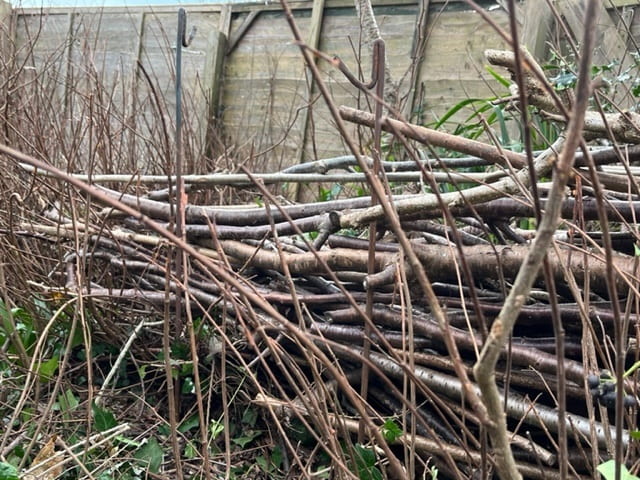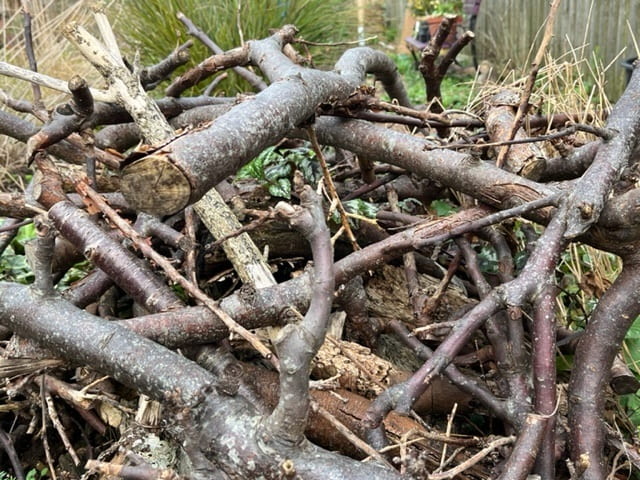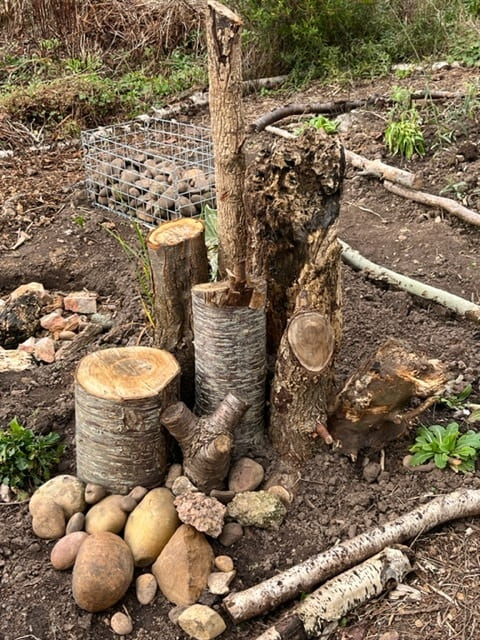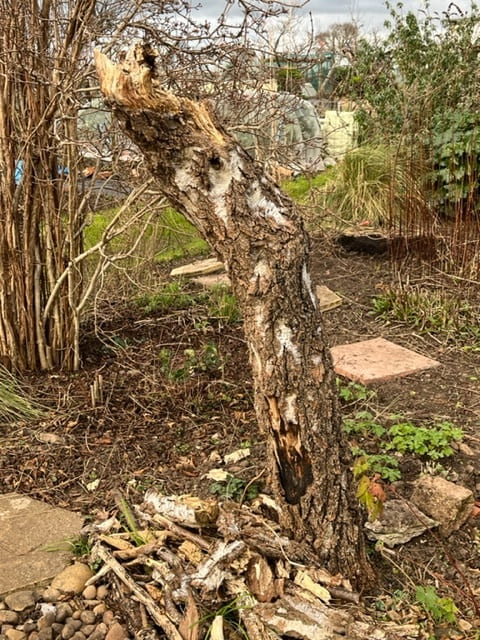Log piles I have built
Log piles are a really important part of a wildlife garden for a variety of reasons.
- They provide shelter and a habitat for many insects, beetles, birds and reptiles.
- As the wood rots down, it creates space to put more on top so offering a way of getting rid of twigs, branches, trunks and everything in between.
- They can sit quietly where no one notices or they can be a designed feature of the garden – they can be large or small.
Here are a selection that we have on the wildlife plot – all built slightly differently.

My first log pile is a dead hedge or what some people call a brash pile. I have used metal rods to provide a support to contain the branches and then laid them reasonably neatly along the length of the supports. I intend to increase the length of this dead hedge with hazel supports to provide a boundary between the plot and my garden neighbour. Dead hedges do not have to follow a straight line but can weave and snake around. On the plot ivy is starting to grow through and over it, providing even more shelter for whoever uses it. The whippy growths at the front of it are elm roots running and sprouting as the dead elms are cut down. There are some nice examples of dead hedging here.

The second log pile is probably what most people think of as a log pile. This one consists of trees cut down and then stacked in situ. We had to cut several cherries and dead elms down just to open up the site a little and to prevent too many of one particular thing taking over. Someone will use the bigger chunks as firewood eventually but here they sit, providing shelter for now. You can make excellent decorative piles with logs such as those created by Nigel Dunnett in what he calls wave form log piles. They look stunning when the plants are in flower and as they die down. I think for those structures, the logs are better if all cut to the same length, spread out and then you can choose which ones to put on the base and make use of the smaller and smaller branches as you go build up.

Next up is a log pile that was already on the plot when I started to work on it. This is in a shady corner and made out of awkward shaped bits of branches usually with 2 or 3 smaller branches coming off them. This is a good place to put the knobbly bits. The pile has been here long enough for dead nettle and harebells to grow through and around it. It is at the bottom of the bed near the pond and I do wonder who uses it – are the newts sheltered in there? I have seen a toad sitting in there a couple of years ago.

This is my latest log pile. It is in the Brownfield Site bed and rather than lay the logs down on their side, I have stood them up on end. I dug a pit about 30 – 40 cms deep and then buried the logs in it. This log pile is in full sun so will be used more by insects and others that like to bask. The stones at the base also provide a basking site so we will see who visits when we get a bit of sunshine.
I have also gone one step further in other parts of the wildlife plot and planted dead trees. They have peeling bark, some have woodworm and other creatures who have already attacked them but dead wood is dead wood and they will crumble and rot away just like a wood pile. They may also, however, offer perching places for birds. The tree I have planted are from dead elder and a Euonymus europaeus that blew down in storm Arwin.

And, finally the last wood pile was already on the plot so I didn’t build it. Leave a tree trunk of a tree that you no longer need. It will rot and decay and bits will fall off creating quite a nice pile at the base. This is a fascinating process to watch. There are all sorts of woodlice and spiders living in the peeling bark and something is very neatly shredding the top of the trunk. It would make a good study and one I might do later on in the year just to see who is using it. @grassroofco uses trees in this way.
Have you got any log piles? Who or what uses them?
You can see posts two, three and four in the log pile series here.